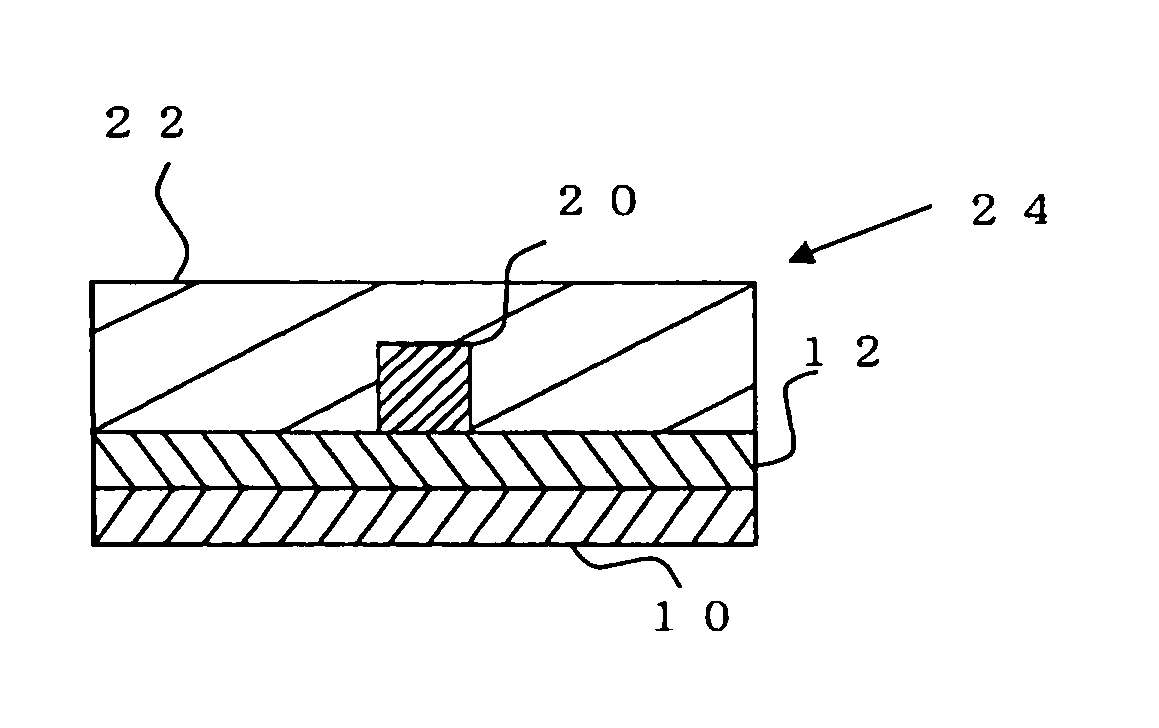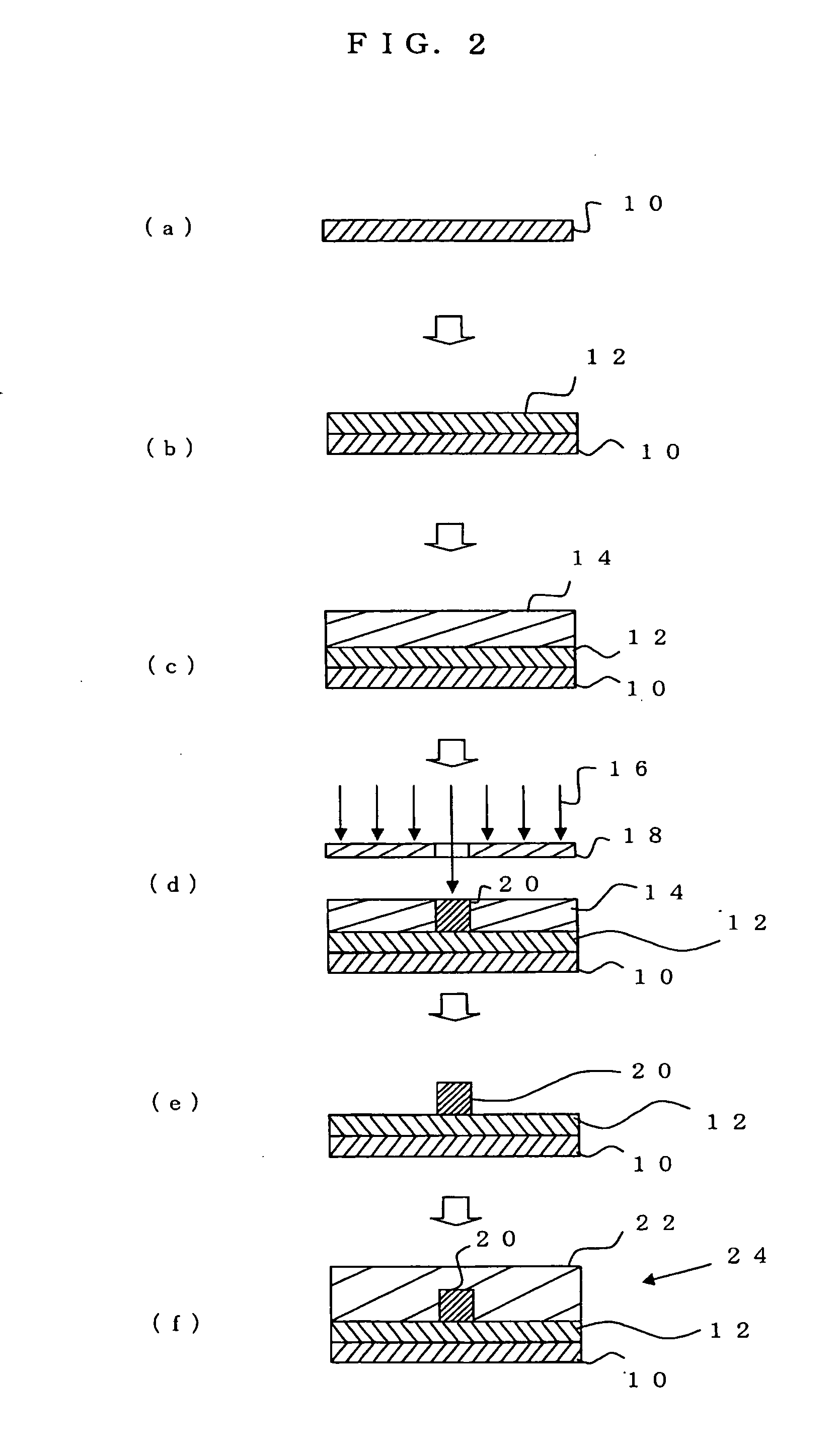Radiation-sensitive resin composition for optical waveguides, optical waveguide, and method for manufacturing optical waveguide
a technology of optical waveguides and resin compositions, applied in the direction of optical elements, photomechanical devices, instruments, etc., can solve the problems of optical waveguides, optical waveguides, optical waveguides, cracks or ruptures when bended, optical waveguides have disadvantages, etc., to achieve excellent bending resistance, high dimensional accuracy, good transmission characteristics
- Summary
- Abstract
- Description
- Claims
- Application Information
AI Technical Summary
Benefits of technology
Problems solved by technology
Method used
Image
Examples
preparation example 1
[0134] After the system of a flask equipped with a dry ice / methanol reflux tube was purged with nitrogen, 3 g of 2,2′-azobisisobutyronitrile as a polymerization initiator, 115 g of propylene glycol monomethyl ether acetate as an organic solvent were put into the flask, and then, stirred until the polymerization initiator was dissolved. Next, 20 g of hydroxyethyl methacrylate, 30 g of dicyclopentanyl acrylate, 25 g of styrene, and 25 g of n-butyl acrylate were put into the flask, and stirring started slowly. The solution was then heated to a temperature of 80 degree C., and the polymerization was carried out for 6 hours at the temperature. Next, after 0.13 g of di-n-butyltin dilaurate and 0.05 g of 2,6-di-t-butyl-p-cresol were added to the obtained solution, 23.7 g of 2-methacryloxyethyl isocyanate was dropped while stirring at a temperature below 60 degree C. The reaction was then carried out for 5 hours at a temperature of 60 degree C., thus obtaining a polymer solution having a me...
preparation example 2
[0135] After the system of a flask equipped with a dry ice / methanol reflux tube was purged with nitrogen, 3 g of 2,2′-azobisisobutyronitrile as a polymerization initiator, 150 g of ethyl lactate as an organic solvent were put into the flask, and then, stirred until the polymerization initiator was dissolved. Next, 20 g of methacrylic acid, 30 g of dicyclopentanyl acrylate, 25 g of styrene, and 25 g of n-butyl acrylate were put into the flask, and stirring started slowly. The solution was then heated to a temperature of 80 degree C., and the polymerization was carried out for 6 hours at the temperature. Next, 10.5 g of 3,4-epoxycyclohexylmethyl acrylate, 0.8 g of tetrabutylammonium bromide, and 0.1 g of p-methoxyphenol were added to the obtained solution, and heated for 7 hours at a temperature of 80 degree C., thus obtaining a polymer solution having an acryl group in the side chain. Then, the reaction product was added into a large amount of hexane to coagulate the reaction product...
preparation example 3
[0136] After the system of a flask equipped with a dry ice / methanol reflux tube was purged with nitrogen, 1.5 g of 2,2′-azobis(2,4-dimethylvaleronitrile) as a polymerization initiator, 115 g of propylene glycol monomethyl ether acetate as an organic solvent were put into the flask, and then, stirred until the polymerization initiator was dissolved. Next, 20 g of hydroxyethyl methacrylate, 25 g of dicyclopentanyl acrylate, 40 g of methyl methacrylate, and 15 g of n-butyl acrylate were put into the flask, and stirring started slowly. The solution was then heated to a temperature of 70 degree C., and the polymerization was carried out for 6 hours at the temperature. After 0.12 g of di-n-butyltin dilaurate and 0.05 g of 2,6-di-t-butyl-p-cresol were added to the obtained solution, 23.7 g of 2-methacryloxyethyl isocyanate was dropped while stirring at a temperature below 60 degree C. The reaction was then carried out for 5 hours at a temperature of 60 degree C., thus obtaining a polymer s...
PUM
| Property | Measurement | Unit |
|---|---|---|
| Fraction | aaaaa | aaaaa |
| Pressure | aaaaa | aaaaa |
| Fraction | aaaaa | aaaaa |
Abstract
Description
Claims
Application Information
 Login to View More
Login to View More - R&D
- Intellectual Property
- Life Sciences
- Materials
- Tech Scout
- Unparalleled Data Quality
- Higher Quality Content
- 60% Fewer Hallucinations
Browse by: Latest US Patents, China's latest patents, Technical Efficacy Thesaurus, Application Domain, Technology Topic, Popular Technical Reports.
© 2025 PatSnap. All rights reserved.Legal|Privacy policy|Modern Slavery Act Transparency Statement|Sitemap|About US| Contact US: help@patsnap.com



